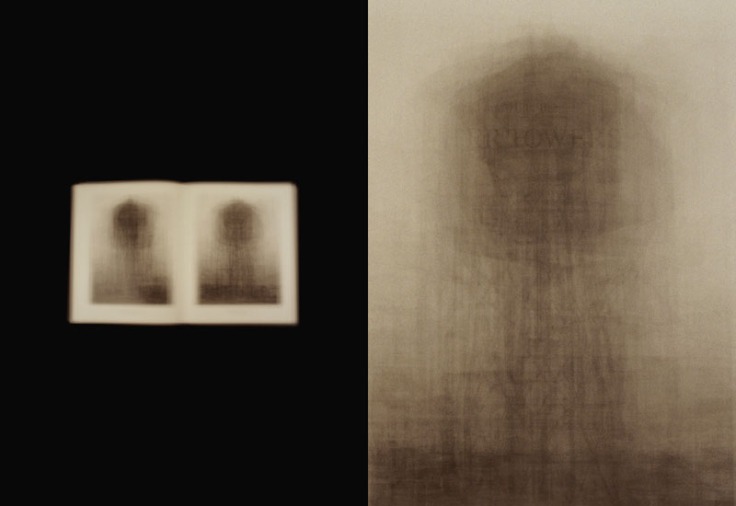
Copyright Doug Keyes 2008 Courtesy DECODE Books
In Doug Keyes photobook, Collective Memory, he utilizes the multiple images of book pages to create complex visual metaphors for memory, and indirectly the duration of time, providing a conceptual product that can only be approximated with photography. An overview of his process is nicely stated in the accompanying essay by Sheryl Conkelton, who writes;
As a photographer, Keyes is also a maker of books, though in a very different way. His photographs of books – art books, works of fiction, popular science paperbacks, works of poetry, textbooks, books on scientific theories – do not describe; instead they are evocative transformations of specific objects. Each photograph shows an open book against a black background; each is sized to echo the actual size of the book being photographed, and Keyes chooses the pages that he thinks will invoke the essence of that particular volume. But semblance ends there and Keyes further elaborates this conceit using multiple exposures so that the book is translated from an object held in the hand to one that vibrates visually, from a utilitarian thing to provocative matter.
Through the use of multiple exposures, Keyes makes the opaque pages of a book transparent, a phenomenon similar to the long exposures by Debra Bloomfield, rendering transparent water opaque, or Chris McCaw, Mark Klett and Michael Lundgren creating a sky with multiple and streaking suns, moons and stars. We can now visualize the difficult and somewhat unfathomable effects of extended time. The duration of time also indirectly speaks to the current moment of visualizing an event now, such as you are reading these WORDS and what becomes of that memory of what you just read?
The mind can store a tremendous amount of information, but usually as discreet visual images. Looking at a series of Watertower photographs by Bernd & Hilla Beacher we may recall the design, texture and mass of an individual Watertower, but not a composite of those images into an overall collective fusion, similar to Keyes’s image below. Paging through the Beacher Watertower book may create a cognitive blurring of the repetitive details, but the finite memory is unlike any that Keyes constructs, thus a new conceptual “reality” and product.
The fascination with memories can be traced to the artistic lineage of investigating the hidden consciousness; turn of the 20th century ideas by Freud and the Dada-ist, subsequently the allegorical Surrealist abstractions and Man Ray, Somnambulist inquires of dreams and dream-walking by Duane Michals, Ralph Gibson and Jerry Uelsmann and Deja-vu, the openness to past lives and altered existences, also by Ralph Gibson. Regretfully, the homage to memories is seemingly becoming a cliché, as many current contemporary photographers allude to the investigation of memories in their conceptual projects, with the concept becoming redundant.
Delightfully though, Keyes provocative images seem to transcend beyond the common memory allegories and engage in a discourse about inner thoughts and dreams. His photographs provide an interesting spectrum, capturing a faint trace of a book’s content to providing a heavy intricate canopy of multicolored mass and textures, not unlike the Abstract Expressionist painting.
The photographs of the Chuck Close book, below, hints of the act of stereotyping, the blurring of physical attributes to generalize personal characteristics, such as a nationality, into a bland non-specific grouping, e.g. “I can’t distinguish one Irishman from another, and they all look alike to me”. But the resulting blurring of the Close images does not represent a “typical blueprint” of anyone in particular, an essential element of the stereotyping process. The features are not well defined, we can not extract the sullen red hair, round soft face, sagging jowls, a sea of freckles, deep creases extending across the forehead, or sunken eye sockets. Thus Keyes layered photograph of Close’s book does not generalize a specific person or group of individuals. The blurring of the features does allude to the loss of specifics over time, which sharp features seem to become soft and faded as our memory betrays us.
Keyes is asking what is remembered, retained and able to be recalled as each pages passes, how dim does the proceeding page become with focus on the current page? How does the memory of the images begin to fade, what details remain sharp, while others are enveloped in a cloud of fog? These images are linked to memory of past events, persons, things seen, felt, experienced but quickly becoming layered, replaced with new images, feelings and experiences; the memories becoming stacked, blurred, and slowly softened
The human capacity to remember clearly defined events, and how the event stack and become layered, will slowly diffuse the fact from the soft memory of what might have been. Not unlike the childhood memories of grandmother’s huge and palatial house and returning later as an adult and realizing how diminutive the house really was. As humans, our inexact memories provide but a distant approximation to reality. If you think not, recall a book you read at least a month ago and see if you can correctly recall all the content that was on page 14 or page 86 or the second to the last page.
As an object, the content within these photographs take on a soft patina, with indistinct edges, fuzzy lines, soft spaces, shapes and mass not well defined. Two dimensional space is difficult to read other than the subject is itself is a book, but with ambiguous content. Keyes allows a particular layer to illuminate though, providing a hint as to what the book itself may be about, but allowing conjecture as to the reason for the book and what the photograph may mean.
By Douglas Stockdale



